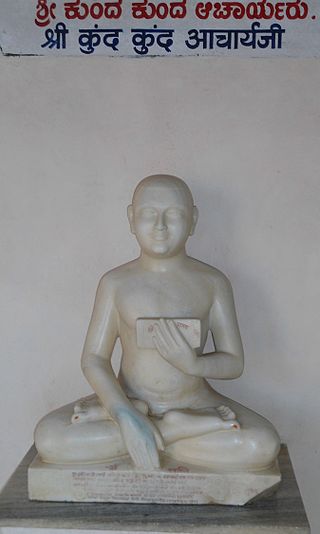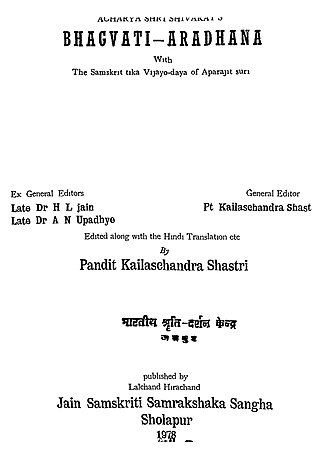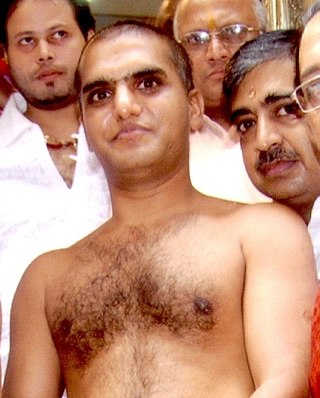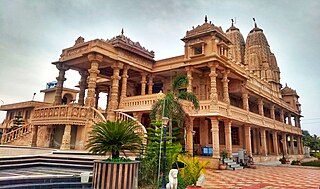
Jainism, also known as Jain Dharma, is an Indian religion. Jainism traces its spiritual ideas and history through the succession of twenty-four tirthankaras, with the first in the current time cycle being Rishabhadeva, whom the tradition holds to have lived millions of years ago, the twenty-third tirthankara Parshvanatha, whom historians date to the 9th century BCE, and the twenty-fourth tirthankara Mahavira, around 600 BCE. Jainism is considered an eternal dharma with the tirthankaras guiding every time cycle of the cosmology. Central to understanding Jain philosophy is the concept of bhedvigyān, or the clear distinction in the nature of the soul and non-soul entities. This principle underscores the innate purity and potential for liberation within every soul, distinct from the physical and mental elements that bind it to the cycle of birth and rebirth. Recognizing and internalizing this separation is essential for spiritual progress and the attainment of samyak darshan or self realization, which marks the beginning of the aspirant's journey towards liberation. The three main pillars of Jainism are ahiṃsā (non-violence), anekāntavāda (non-absolutism), and aparigraha (asceticism).

The Śvetāmbara is one of the two main branches of Jainism, the other being the Digambara. Śvetāmbara in Sanskrit means "white-clad", and refers to its ascetics' practice of wearing white clothes, which sets it apart from the Digambara or "sky-clad" Jains whose ascetic practitioners go nude. Śvetāmbaras do not believe that ascetics must practice nudity.

Ācārya Bhadrabāhu was, according to both the Śvetāmbara and Digambara sects of Jainism, the last Shruta Kevalin in Jainism.

Jain monasticism refers to the order of monks and nuns in the Jain community and can be divided into two major denominations: the Digambara and the Śvētāmbara. The monastic practices of the two major sects vary greatly, but the major principles of both are identical. Five mahāvratas, from Mahavira's teachings, are followed by all Jain ascetics of both the sects. Historians believe that a united Jain sangha (community) existed before 367 BCE, about 160 years after the moksha (liberation) of Mahavira. The community then gradually divided into the major denominations. However, no evidences indicate when the schism between the Digambaras and the Śvetāmbaras happened.
Kumudendu Muni was a Digambara monk who authored Siribhoovalaya, a unique multi-lingual literary work. Scholars are divided about when he lived and not much is known about him. It is believed that he was the spiritual teacher of King Amoghavarsha and a disciple of Virasena and Jinasena. He is said to have lived around thousand years ago. Pandit Yellappa Shashtri was the first one to decipher his creation, Siribhoovalaya. Karlamangalam Srikantaiah, the editor of the first edition, claims that the work may have been composed around 800 AD.

The Bhaktāmara Stotra is a Jain religious hymn (stotra) written in Sanskrit. It was authored by Manatunga. The Digambaras believe it has 48 verses while Śvetāmbaras believe it consists of 44 verses.

Jainism is a religion founded in ancient India. Jains trace their history through twenty-four tirthankara and revere Rishabhanatha as the first tirthankara. The last two tirthankara, the 23rd tirthankara Parshvanatha and the 24th tirthankara Mahavira are considered historical figures. According to Jain texts, the 22nd tirthankara Neminatha lived about 84,000 years ago and was the cousin of Krishna.
Mulachara is a Jain text composed by Acharya Vattakera of the Digambara tradition, around 150 CE. Mulachara discusses anagara-dharma – the conduct of a Digambara monk. It consists twelve chapters and 1,243 verses on. It is also called Digambara Acharanga. It is said to be derived from the original Ācārāṅga Sūtra and discusses the conduct of a Digambara monk.

Digambara is one of the two major schools of Jainism, the other being Śvetāmbara (white-clad). The Sanskrit word Digambara means "sky-clad", referring to their traditional monastic practice of neither possessing nor wearing any clothes.

Acharya Manatunga was the author of the Jain prayer Bhaktamara Stotra. His name only appears in the last stanza of the said prayer. He is also credited with composing another Śvetāmbara hymn titled Namiun Stotra or Bhayahara Stotra, an adoration of Parshvanatha.

Jainism is an Indian religion which is traditionally believed to be propagated by twenty-four spiritual teachers known as tirthankara. Broadly, Jainism is divided into two major schools of thought, Digambara and Śvetāmbara. These are further divided into different sub-sects and traditions. While there are differences in practices, the core philosophy and main principles of each sect is the same.

A Digambara monk or Digambara Sādhu is a Sādhu in the Digambar tradition of Jainism, and as such an occupant of the highest limb of the four-fold sangha. Digambar Sādhus have 28 primary attributes which includes observance of the five supreme vows of ahimsa (non-injury), truth, non-thieving, celibacy and non-possession. A Digambar Sādhu is allowed to keep only a feather whisk, a water gourd and scripture with him.

Aryika, also known as Sadhvi, is a female mendicant (nun) in Jainism.

Aparajita was an eighth century Digambara monk.

He know as bhaktamar wale baba Muni Shri 108 Pranamsagar Ji Maharaj is a Digambara monk.
AcharyaDharasena was a Digambara monk of first century CE.

Upadhyaya Shri Guptisagarji is a Digambara monk who currently has the rank of an Upadhyaya. Born in 1957, he took ailak diksha under Acharya Vidyasagar ji in 1980, Muni diksha in 1982 also under Acharya Vidyasagar. He was initiated an Upadhyaya by Acharya Vidyanand ji in 1991. He is the inspiration behind Gupti Dham Jain Mandir, Ganaur, Sonipat.
Vidyananda was a Digambara logician, scholar and Jain monk in Pataliputra. He was born in 750 AD and died in 800. He wrote Ashtasahasri which is a commentary on Samantabhadra's Devagamastotra. Madhvacharya, a Hindu philosopher has mentioned Vidyananda. Another digambaraacharya with the same name flourished in the 20th-century India.
Guņabhadra was a Digambara monk in India. He co-authored Mahapurana along with Jinasena.












